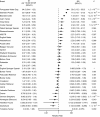Naturally Occurring Adrenocortical Insufficiency--An Epidemiological Study Based on a Swedish-Insured Dog Population of 525,028 Dogs
- PMID: 26683136
- PMCID: PMC4913634
- DOI: 10.1111/jvim.13815
Naturally Occurring Adrenocortical Insufficiency--An Epidemiological Study Based on a Swedish-Insured Dog Population of 525,028 Dogs
Abstract
Background: Naturally occurring adrenocortical insufficiency (NOAI) in dogs is considered an uncommon disease with good prognosis with hormonal replacement treatment. However, there are no epidemiological studies with estimates for the general dog population.
Objectives: To investigate the epidemiological characteristics of NOAI in a large population of insured dogs.
Animals: Data were derived from 525,028 client-owned dogs insured by a Swedish insurance company representing 2,364,652 dog-years at risk (DYAR) during the period between 1995-2006.
Methods: Retrospective cohort study. Incidence rates, prevalences, and relative risks for dogs with NOAI (AI with no previous claim for hypercortisolism), were calculated for the whole dog population, and for subgroups divided by breed and sex. Mortality rates were calculated and compared in dogs with NOAI and the remaining dogs overall.
Results: In total 534 dogs were identified with NOAI. The overall incidence was 2.3 cases per 10,000 DYAR. The relative risk of disease was significantly higher in the Portuguese Water Dog, Standard Poodle, Bearded Collie, Cairn Terrier, and Cocker Spaniel compared with other breeds combined. Female dogs overall were at higher risk of developing AI than male dogs (RR 1.85; 95% CI, 1.55-2.22; P < .001). The relative risk of death was 1.9 times higher in dogs with NOAI than in dogs overall.
Conclusion and clinical importance: The data supports the existence of breed-specific differences in incidence rates of NOAI in dogs.
Keywords: Addison's disease; Hypoadrenocorticism; Incidence.
Copyright © 2015 The Authors. Journal of Veterinary Internal Medicine published by Wiley Periodicals, Inc. on behalf of the American College of Veterinary Internal Medicine.
Figures



References
-
- Kelch WJ. Canine Hypoadrenocorticism (Canine Addison′s disease): History, Contemporary Diagnosis by Practicing Veterinarians, and Epidemiology [dissertation]. Knowville: University of Tennessee; 1996.
-
- Kelch WJ, Lynn RC, Smith CA, New JC. Canine hypoadrenocorticism (Addison′s disease). Comp Small Anim Pract 1998;20:921–934.
-
- Peterson ME, Kintzer PP, Kass PH. Pretreatment clinical and laboratory findings in dogs with hypoadrenocorticism: 225 cases (1979–1993). J Am Vet Med Assoc 1996;208:85–91. - PubMed
-
- Feldman EC, Nelson RW. Hypoadrenocorticism (Addison's disease) In Canine and Feline Endocrinology and Reproduction, 3rd ed St. Louis: Saunders; 2004:394–439.
-
- Famula TR, Belanger JM, Oberbauer AM. Heritability and complex segregation analysis of hypoadrenocorticism in the standard poodle. J Small Anim Pract 2003;44:8–12. - PubMed
Publication types
MeSH terms
LinkOut - more resources
Full Text Sources
Other Literature Sources
Medical

